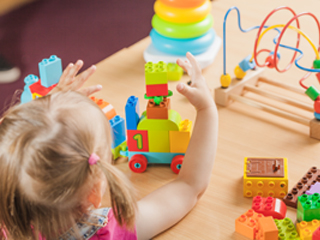
From the moment parents greet their newborn child, they eagerly watch the baby\’s progress, anticipating every development, every marker in growth. The first five years of life are the most important as this is when the maximum amount of growth takes place. Infants learn to balance their heads, crawl, walk and learn simple responses like smiling and greeting in these early years. That said, it’s important to note that each child develops at their own pace — a pace not necessarily the same as others. Most of the time, babies reach each developmental milestone around the expected age, and if not, they catch up soon enough. It is common for a child to be ahead in one area, such as language, but a little behind in another.
The first five years. Developmental milestones to look for.
It’s natural then for parents to ask, “How do I know if my child is developing normally?” An often used method is to compare their child’s physical, intellectual and behavioral development to that of others in the same age bracket. While it’s best to check with your pediatrician, comparing with other infants and referring to a growth milestone chart can help you spot problems early. Here are some highlights of your child’s growth journey.
0 – 3 Months
Begins to develop a social smile
Raises head and chest when lying on the stomach
Notices and recognizes faces
Smiles at the sound of your voice
Starts holding head steady
Reaches for an object
3 – 6 Months
Enjoys social play (games like peek-a-boo)
Transfers objects from hand to hand
Responds to name
Rolls over, lying down
Finds partially hidden objects
Picks up toys and objects
6-12 Months
Responds to simple verbal requests
Sits without any assistance
Stands with assistance
Crawls up the stairs
Feeds self with spoon
Enjoys imitating people/things in his play
1-2 Years
Walks without assistance
Points to interesting objects
Lifts cup to mouth
Uses 2-4 word phrases to communicate
Shows interest in other children
Turns pages of a book
2-3 Years
Plays make-believe with dolls, animals, and people.
Sorts objects by shape and color
Climbs stairs and jump with two feet
Kicks ball without losing balance
Wiggles thumbs
Understands concepts of today, tomorrow, and yesterday
3-4 Years
Walks on tiptoes
Hops on one foot
Knows his name and gender
Feeds himself without spilling much
Brushes teeth and dresses without help
Unscrew jars, turns door knobs and scribbles
4-5 Years
Cooperates with other children
Plays on the swing without assistance
Balances on one foot for at least five seconds
Draws circles, triangles and squares
Counts up to 10 or more
Likes to sing or dance
When to worry and when not to.
For children who don’t meet their cognitive and motor milestones on time, it’s advisable to wait for a few months and watch for progress before raising an alarm. It’s best to consult a medical professional in case of delays longer than 2-4 months; any motor developmental delay is a warning sign. Often, an early intervention in developmental delays or developmental disabilities can go a long way in reducing the extent or nature of the problem.
Symptoms of developmental delays:
- Any motor development delays (as per age-specific milestones), for example, a 6-month-old child with little head control
- Low interest in playing with other children or caregivers
- Difficulty making eye contact to get someone’s attention or communicating needs
- Overactive and displays impulsive and inattentive behavior
- Poor memory, difficulty remembering names, letters and numbers
- Hard time reading and recognizing letters and words
- Problems with fine motor skills, such as coloring and writing
- Reluctance to use one side of the body, such as reaching with only one hand
- Involuntary movements, spasms or tremors
As a parent, watching your children grow up is a uniquely fulfilling experience. To ensure their development is holistic and normal, we encourage you to periodically monitor their behavior for any anomalies. If you have reason to believe that their growth could be hindered at any stage, get in touch with Dr Naeem at drnaeem@plexusnc.com. Together, we can create a child-friendly environment and help bring their development back on track.










